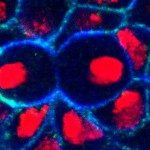Lien vers Pubmed [PMID] – 11171389
Development 2001 Mar;128(5):631-43
The stereotyped pattern of the Drosophila embryonic peripheral nervous system (PNS) makes it an ideal system to use to identify mutations affecting cell polarity during asymmetric cell division. However, the characterisation of such mutations requires a detailed description of the polarity of the asymmetric divisions in the sensory organ lineages. We describe the pattern of cell divisions generating the vp1-vp4a mono-innervated external sense (es) organs. Each sensory organ precursor (SOP) cell follows a series of four asymmetric cell divisions that generate the four es organs cells (the socket, shaft, sheath cells and the es neurone) together with one multidendritic (md) neurone. This lineage is distinct from any of the previously proposed es lineages. Strikingly, the stereotyped pattern of cell divisions in this lineage is identical to those described for the embryonic chordotonal organ lineage and for the adult thoracic bristle lineage. Our analysis reveals that the vp2-vp4a SOP cells divide with a planar polarity to generate a dorsal pIIa cell and a ventral pIIb cell. The pIIb cell next divides with an apical-basal polarity to generate a basal daughter cell that differentiates as an md neurone. We found that Inscuteable specifically accumulated at the apical pole of the dividing pIIb cell and regulated the polarity of the pIIb division. This study establishes for the first time the function of Inscuteable in the PNS, and provides the basis for studying the mechanisms controlling planar and apical-basal cell polarities in the embryonic sensory organ lineages.

